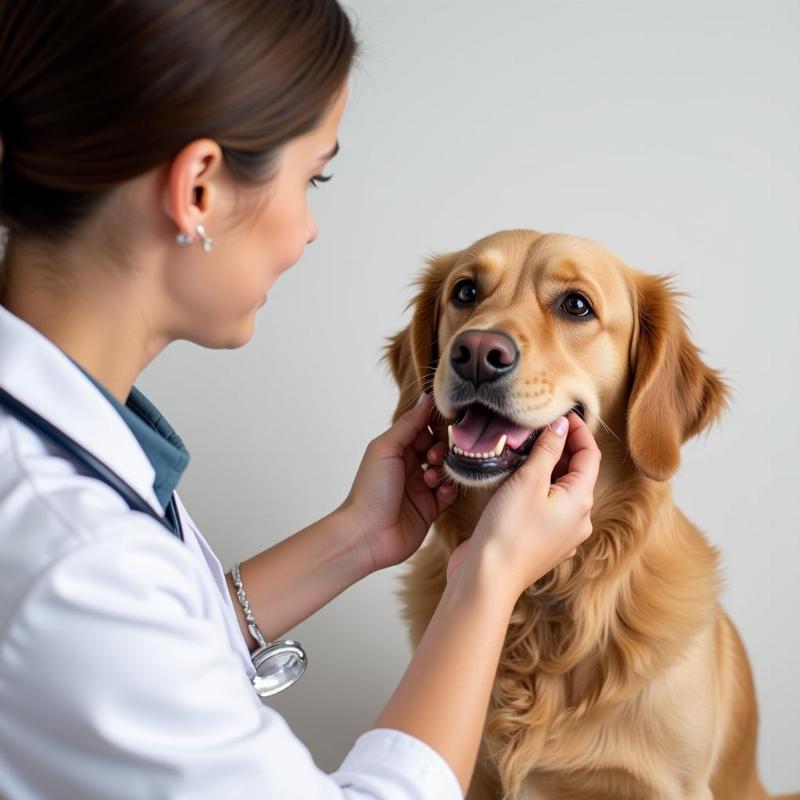Losing teeth is a common occurrence in older dogs, and it can make mealtimes challenging. Knowing how to feed a dog with no teeth is essential for ensuring they receive proper nutrition and maintain a healthy weight. This article will guide you through the best practices for feeding your toothless canine companion, covering everything from dietary adjustments to specialized products available in the US.
Choosing the Right Food for a Toothless Dog
The most important aspect of feeding a dog with no teeth is selecting a diet that is easy to eat and digest. Dry kibble is no longer an option. Instead, consider these alternatives:
- Soft Food: Canned wet food is an excellent choice for dogs without teeth. Look for pate-style varieties, as they are the easiest to consume.
- Homemade Food: Preparing homemade meals allows you to control the ingredients and ensure the food is soft enough. Pureed vegetables, cooked meats, and bone broth can be combined to create a nutritious and palatable meal.
- Soaked Kibble: If your dog prefers kibble, you can try soaking it in warm water or broth until it becomes a soft mush. Ensure it’s completely softened to prevent choking.
Making Mealtimes Easier for Your Toothless Friend
Beyond choosing the right food, several other tips can make mealtimes more enjoyable for your dog:
- Elevated Food Bowls: Raising the food bowl can reduce strain on your dog’s neck and make it easier for them to eat.
- Small, Frequent Meals: Instead of two large meals, offer smaller portions more frequently throughout the day. This can aid digestion and prevent your dog from becoming overwhelmed.
- Hand Feeding: In some cases, hand-feeding may be necessary, especially for very old or weak dogs. This allows you to monitor their intake and ensure they are getting enough to eat.
Nutritional Considerations for Senior Dogs
Older dogs, especially those without teeth, often have different nutritional requirements than younger dogs. Consult with your veterinarian to determine the best diet for your dog’s specific needs. They may recommend supplements or specific formulations to address common senior dog health concerns, such as joint pain or cognitive decline.
 Veterinarian checking senior dog
Veterinarian checking senior dog
Addressing Dental Health Issues in Dogs
While tooth loss is common in older dogs, it can also be a sign of underlying dental problems. Regular dental checkups are crucial for maintaining your dog’s oral health. Even without teeth, your veterinarian can identify and address issues like gum disease or infections.
Common Concerns about Feeding Dogs with No Teeth
Many dog owners worry about their toothless companions getting enough nutrition. With the right approach and dietary adjustments, your dog can thrive even without teeth.
What if my dog won’t eat soft food?
Try different flavors and textures of soft food, or mix it with a small amount of their favorite treats. You can also try warming the food slightly to make it more appealing.
Can I give my dog bones if they have no teeth?
No, avoid giving bones to a dog without teeth. They can splinter and cause choking or digestive problems.
Conclusion
Feeding a dog with no teeth requires a little extra care and attention, but with the right approach, you can ensure your furry friend continues to enjoy mealtimes and receives the necessary nutrients for a healthy life. Remember to consult with your veterinarian for personalized advice and to address any underlying dental health concerns.
FAQ
- What is the best food for a dog with no teeth? Soft, wet food, homemade purees, or soaked kibble are the best options.
- How often should I feed a toothless dog? Smaller, more frequent meals are generally recommended.
- Can a dog with no teeth still eat treats? Yes, soft treats are a great way to reward and spoil your toothless companion.
- What are signs of dental problems in dogs? Bad breath, red or swollen gums, and difficulty eating can all be signs of dental problems.
- Is it normal for senior dogs to lose their teeth? Yes, tooth loss is a common occurrence in older dogs.
- Do I still need to brush my dog’s gums if they have no teeth? Yes, regular gum massage can help prevent gum disease.
- How can I make mealtimes more comfortable for my toothless dog? Use elevated food bowls and try hand-feeding if necessary.
Related Articles
- how to feed dog with no teeth
- what do you feed a dog with no teeth
- powdered goats milk for dogs
- when can i feed my dog after tooth extraction
Beautdogs.us is your premier resource for comprehensive dog care information, breed-specific advice, and access to a wide range of products tailored to your canine companion’s needs. Whether you’re a seasoned dog owner or just starting your journey with a furry friend, Beautdogs.us provides expert guidance and reliable resources to help you navigate every aspect of dog ownership. Contact us today for personalized support and discover how we can help you enhance your dog’s well-being. Email: [email protected], Phone: +1 501-555-7529. Visit us at Beautdogs.us for more information.